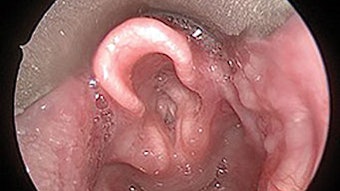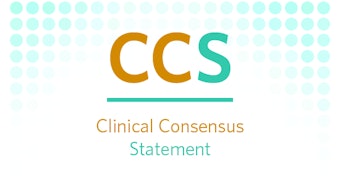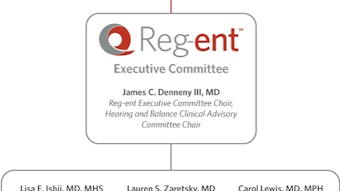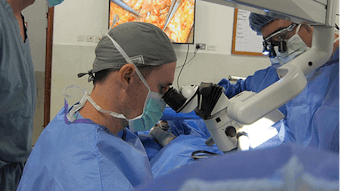Out of Committee: Outcomes Research Evidence-Based Medicine Committee
Management decisions around tracheostomy have been at the forefront of international dialogue in the midst of the COVID-19 pandemic. In this Bulletin segment, our committee shares highlights from key developments in this space, with detailed analysis of the largest implementation to date of a prospective multidisciplinary tracheostomy team approach. We provide concise summaries of salient findings from current studies that may inform high-stakes decision making and surgical practice in otolaryngology.
Data-Driven Multidisciplinary Tracheostomy Care—Preventing Harm and Improving Lives
OREBM Publication Spotlight
Michael J. Brenner, MD, Joshua R. Bedwell, MD, and Vikas Mehta, MD

Management decisions around tracheostomy have been at the forefront of international dialogue in the midst of the COVID-19 pandemic. In this Bulletin segment, our committee shares highlights from key developments in this space, with detailed analysis of the largest implementation to date of a prospective multidisciplinary tracheostomy team approach. We provide concise summaries of salient findings from current studies that may inform high-stakes decision making and surgical practice in otolaryngology.
Forthcoming Publications
- McGrath BA, Wallace W, Lynch J, et al. Improving tracheostomy care in the United Kingdom: Results of a guided quality improvement program in 20 diverse sites. Br J Anaesth. Forthcoming.
- Brenner MJ, Pandian V, Milliren C, et al. Global Tracheostomy Collaborative: data-driven improvements in patient safety through multidisciplinary teamwork, standardization, education and patient partnership. Br J Anaesth. Forthcoming.
- Cherney RL, Pandian V, Eastman D, et al. The Trach Trail: a systems-based pathway to improve quality of tracheostomy care and interdisciplinary collaboration. Otolaryngol Head Neck Surg. Forthcoming.
- McGrath BA*, Brenner MJ*, Warrillow S, et al. Tracheostomy in the COVID-19 era: global and multidisciplinary guidance. Lancet. Forthcoming.
The impetus for change:
Tracheostomy is a marker for medical complexity with significant adverse events occurring in 10% to 20% of patients.1,2 A landmark study found that in ICUs, tracheostomy was implicated in up to half of all airway-related deaths and instances of hypoxic brain injury.3 Other well known complications include tracheostomy tube occlusion, accidental dislodgement, hemorrhage, infection, pneumothorax, granulation tissue, airway stenosis, tracheoinnominate artery fistula, tracheoesophageal fistula, and aspiration.1 The United Kingdom’s National Confidential Enquiry into Patient Outcomes and Death further illuminated the concerning shortfalls in care, documenting lack of coordinated efforts, insufficient education and protocols, and systems failures as root causes of preventable harm.2
These reports catalyzed international efforts to improve the standard of care for patients with tracheostomy. The UK National Tracheostomy Safety Project (NTSP, www.tracheostomy.org.uk) and the Global Tracheostomy Collaborative (GTC, www.globaltrach.org) evolved to provide structures for coordinating improvement efforts across institutions, facilitating data capture and analysis. Five key drivers of outcomes were identified to improve patient care: multidisciplinary ward rounds, standardized protocols, interdisciplinary education, patient and family involvement, and data-driven solutions.4 Multidisciplinary tracheostomy teams at individual sites have achieved dramatic reductions in adverse events and improved patient outcomes. However, widespread dissemination and adoption of successful practices have lagged, with questions remaining as to whether such improvements are generalizable across institutions. Prior studies have been limited by emphasis on outcomes of adverse events and mortality with far less data available on patient quality of life and economic measures.
Largest prospective study to date on multidisciplinary tracheostomy care
Design
McGrath, et al. reports in the British Journal of Anesthesia on a three-year, 20-hospital, multipronged quality improvement initiative involving 2,405 tracheostomy patient admissions. The hospitals were distributed throughout the United Kingdom including adult, pediatric, and combined sites. The outcomes evaluated included overall hospital length of stay, ICU stay, ventilator duration, time to cuff deflation, time to first vocalization, time to first oral intake, prevalence of anxiety and depression, and economic impact. Mixed methods analysis, data tracking, and benchmarking were combined to evaluate effects of implementation. Sites were enrolled in three waves, with respective institutions undertaking incremental adoption of interventions identified to improve outcomes. A total of 18 interventions relating to themes of patient safety, patient-focused quality of care, and organizational efficiency were adopted.
Methodology
Individual sites captured patient-level data prospectively using a GTC-specific REDCap database, with additional linked data obtained from critical care datasets and local incident reporting. Qualitative data collection involved use of validated survey instruments and interviews for both patients and staff. The authors performed appropriate quantitative and qualitative analyses, including nonparametric linear regression to identify predictive variables, and the use of NVIvo for qualitative analysis of interview and survey data. Economic evaluation was calculated using NHS national schedule of cost, with independent financial analyses conducted to minimize risk of bias. The time course of implementation was monitored, with most sites requiring 12 months to achieve implementation of objectives.
Results
Study findings included significant improvements for all 20 sites enrolled. A total of 727 clinical patient safety events were reported, with significant reductions in adverse events over time. Patients spent fewer days in the ICU, days on the ventilator, days with tracheostomy, and days in the hospital (all p <.01). Several patient-centered quality of life outcomes improved, including a dramatic reduction in the time to first oral intake (from 26 to 9 days, p<0.01), and time to cuff-deflation and vocalization (each reduced by 1 week, p<0.05). Measures of patient mental health similarly benefitted, with reduced anxiety (down from 35.9% to 20%, p<0.01) and depression (from 38.7% to 18.3%, p<0.01). The economic analyses demonstrated £15,200 savings per patient, with projected savings to NHS of £275 million annually (US $341 million). Limitations included inclusion of sites only in the United Kingdom and lack of random assignment, as the study was a quality improvement implementation.
GTC reports on >5000 prospective tracheostomy admissions: the Trach Trail
Two other studies provide important supporting data regarding the power of multidisciplinary team-based care to transform tracheostomy care. The GTC international report details findings of prospective data collection on over 5000 patients with tracheostomy, presenting a model of risk and identifying powerful predictors of adverse events, length of stay, and mortality, such as comorbidities and admitting diagnosis. It also highlights an association of bleeding events after tracheostomy with mortality. The Trach Trail represents a systems-based pathway implemented at University of Michigan that reduced ICU length of stay. The findings are particularly significant given that ICU capacity strain (involving ICU beds, staff, and ventilators) have proven a critical choke point in the COVID-19 era.
Tracheostomy in the COVID-19 Era: Global and Multidisciplinary Guidance
Finally, the consensus guidance document, in press for The Lancet Respiratory Medicine, brings together thought leaders from the United States, the United Kingdom, Italy, Spain, France, Germany, Switzerland, Australia, Hong Kong, Beijing, Shanghai, and Wuhan China, examining practices through lenses of pandemic history, medical ethics, resource scarcity, and patient advocates alongside stakeholders in diverse clinical disciplines (otolaryngology, anesthesia critical care, pulmonology, intensive care, infectious disease, virology/immunology, respiratory therapy, speech and language pathology, and nursing). A modified Delphi technique was used to generate recommendations regarding indications for tracheostomy, case selection, timing of tracheostomy, setting/location, procedural approach/personal protective equipment (PPE), and optimal management strategies following tracheostomy.
Conclusions
The results of these collective studies are particularly relevant to otolaryngologists and other specialists involved in tracheostomy care in the United States and beyond. The COVID-19 pandemic has led to a surge in critically ill patients, a significant number of whom may go on to require tracheostomy. Given what we know about the baseline prevalence of tracheostomy-related adverse events and effects on patient quality of life, there is much room for improvement. Dr. McGrath and colleagues have demonstrated the feasibility of improving quality and safety of tracheostomy care in geographically and politically diverse sites, with differing size, operations, and governances. The program is the first to demonstrate improvement at such scale and shows the potential for multidisciplinary interventions to prevent harm, improve the patient experience of living with a tracheostomy, and reduce expenditures.
References
- Das P, Zhu H, Shah RK, Roberson DW, Berry J, Skinner ML. Tracheotomy-related catastrophic events: Results of a national survey. Laryngoscope. 2012;122(1):30-37.
- McGrath BA, Wilkinson K. The NCEPOD study: On the right trach? Lessons for the anaesthetist. Br J Anaesth. 2015;115(2):155-158.
- Cook TM, Woodall N, Frerk C, Fourth National Audit P. Major complications of airway management in the UK: Results of the Fourth National Audit Project of the Royal College of Anaesthetists and the Difficult Airway Society. Part 1: Anaesthesia. Br J Anaesth. 2011;106(5):617-631.
- Bedwell JR, Pandian V, Roberson DW, McGrath BA, Cameron TS, Brenner MJ. Multidisciplinary tracheostomy care: How collaboratives drive quality improvement. Otolaryngol Clin North Am. 2019;52(1):135-147.


















